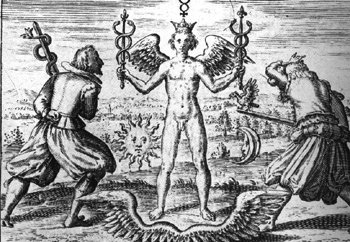

|
- Originally Hermes/Mercurius was the Greco-Roman god of travelers, trade, revelation, and eloquence. He was also associated with Egyptian Thoth. - Mercurius is present in every stage of transformation as striking opposites - He is the simultaneous omnipresence of every level of being and the connecting psychic principle between all beings - the One and the All - Mercurius is hermaphroditic, bisexual, androgenous soul of metals, the ‘metallic’ man; both good and evil, material and spiritual, trickster-like child of Sol and Luna, and also - the son of Tiamat -He has a masculine body and a feminine soul - Mercurius is the Mediator, Servator, Salvator - He is the reflection of mystical experience, the Self, and the individuation process (Jungian psychology) -His corresponding planet and metal is Mercury. Mercurius is also often described as quicksilver, which has a fluid, water-like quality. At the same time, he possesses fiery characteristics, especially in his embodiment as the alchemical gold. He arises from moisture like vapor, while Mercurial fire is found in the center of the earth (or the ‘dragon’s belly’) | 
Verus Hermes (1620) |
 
|
- Mercurius is often referred to as duplex, trinus, and even quaternus: the merged Mercurial dichotomy is linked to his dual nature as an ethically conflicting bisexual hermaphrodite; his trichotomy is related to his manifestation as the counterpart of the Christian Godhead; the synthesis of the elemental quaternity in the Philosopher’s Stone is achieved through Mercurial life-giving power -Mercurius is the Ultima Materia as the Philosopher’s Stone or gold (i.e. the goal of his own transformation). As Mercurius senex, however, he is an initial Saturnine substance from which he extracts himself (i.e. the Prima Materia or lead - hydrargyrum). This makes Mercurius the child of Saturn, which happens to be the dwelling place of the Devil. Thus, Mercurius’ association with the Christian Godhead is complemented by his relationship with the Christian Devil, both as Lucifer, the Light Bringer, and diabolical Satan - As the product of his own transformation, Mercurius is most often associated with the Uroboros, the tail-eating serpent, who devours and gives birth to itself ("himself lifts himself on high"). Because Mercurius is said to be both the circumference and the center of this serpentine ring, he is divine. (Gods are often compared to the center: they are infinite, yet occupy no space) - Mercurius is often used as an allegory or a complement of Chris: 1) both are androgenous; 2) Christ compares himself to the healing snake of Moses, while Mercurius is the Uroboros; 3) Christ is the Son of Man, the Filius Microcosmi, whereas Mercurius is the Cosmic Child, the Filius Macrocosmi (which is also the Philosopher’s Stone and the inner man); 4) Christ is often used as an archetype of consciousness, while Mercurius is an archetype of the unconscious
- Mercurius is related to the Holy Ghost, because he is the spiritual life-giving quintessence which holds the elements together - He is often depicted as a dragon, night raven, roaring lion, cloud, eagle, shadow, fish, stone, unicorn, rhinoceros, water, fire, man encompassed by a woman, etc. |